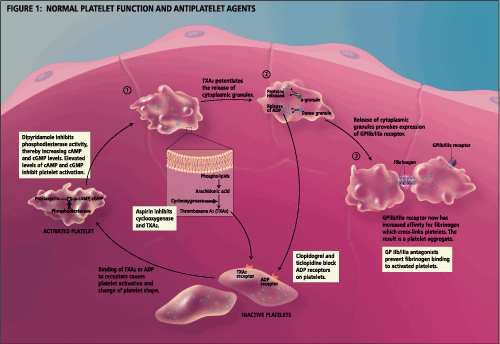A Review of Antiplatelet Therapy in the Secondary Prevention of Stroke in the Elderly
A Review of Antiplatelet Therapy in the Secondary Prevention of Stroke in the Elderly
D'Arcy Little, MD, CCFP
Director of Medical Education,
York Community Services, Toronto
Fan-Hsia Mang, BSc
Elective Medical Student,
University of Alberta, Edmonton
Introduction and Background
Stroke is the third leading cause of death in the industrialized world and is a major cause of long-term disability.1 It is estimated that 40% of patients who survive a first transient ischemic attack (TIA) or stroke will have a subsequent stroke within the next five years.1 As increased age is one of the major non-modifiable risk factors for stroke, secondary prevention of stroke in the elderly population is an important clinical consideration. The following article will review the antiplatelet medications available for the secondary prevention of stroke in the elderly.
According to current guidelines, patients with a first cerebrovascular event due to cardioembolism should be treated with oral anticoagulants, provided there are no contraindications. This topic has already been reviewed previously in this publication.2,3,4 Patients who experience cerebrovascular events secondary to atherothrombosis typically receive antiplatelet agents. Aspirin is the best studied antiplatelet agent used for the secondary prevention of stoke, but in the past decade, other agents have been added to the anti-stroke armamentarium, including ticlopidine (Ticlid), clopidogrel (Plavix) and a combination agent containing dipyridamole and ASA (Aggrenox). 5
Acetylsalicylic Acid (ASA)
Acetylsalicylic acid (ASA, Aspirin) has been used in clinical practice for decades. It acts by irreversibly inhibiting platelet cyclo-oxygenase, subsequently inhibiting the formation of thromboxane A2. Thromboxane A2 is a vasoconstrictor as well as an activator for platelet aggregation and release.6 [See Figure 1: Normal Platelet Function and Antiplatelet Agents]

Early trials, in the 1970's and early 1980's, probing the use of ASA as an antiplatelet agent in the prevention of stroke yielded negative, equivocal or contradictory results, largely due to small sample sizes and population heterogeneity.7 In addition, early trials of alternative antiplatelet agents such as sulfinpyrazone and dipyridamole suggested no significant additional benefit over aspirin.8,9,10
In 1991, however, the United Kingdom Transient Ischemic Attack Trial (UK-TIA) and the Swedish Aspirin Low-dose Trial (SALT) suggested that ASA alone had efficacy for preventing secondary stroke in patients with cerebrovascular disease.7,11,12 The arm of the Second European Stroke Prevention Study (ESPS-2) in which patients received ASA alone demonstrated, among other things, that ASA alone has a highly significant protective effect. The relative stroke risk was decreased by 18.1% with ASA compared to placebo.13,14 In addition, a meta-analysis, The Antiplatelet Trialist's Collaboration (APTC), of 25 randomized trials of various forms of antiplatelet therapy used in the treatment of stoke, TIA, unstable angina and myocardial infarction, revealed that antiplatelet therapy was associated with a 27% reduction in nonfatal stroke (p<0.001) and a 25% reduction in stroke, myocardial infarction, or vascular death (p=0.0001). Most of these trials involved ASA.6,15
Although in the past there has been considerable debate regarding the optimal dose of ASA for secondary stroke prevention, a series of trials have indicated that there is no significant difference in the protective effect of ASA in doses ranging from 30 to 1200 mg/day. Low dose aspirin (50 to 100 mg) reduces the risk of vascular events in patients with prior stroke or TIA by 13%, with no evidence of a dose-response relationship.7,11,12,16 Furthermore, lower-dose ASA has been associated with a reduced incidence of gastric discomfort and gastric bleeding.7,17
Aggrenox (Aspirin and Dipyridamole)
Dipyridamole is a platelet inhibitor that is thought to work by inhibiting platelet phosphodiesterase, raising the anti-aggregating effects of cyclic adenosine monophosphate and cyclic guanosine monophosphate.6,13
